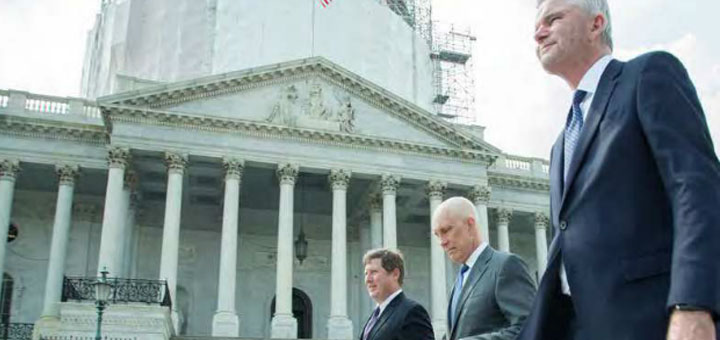The National Retail Federation (NRF) is the world’s largest retail trade association. Its members include grocery, department, specialty, discount, catalog, and internet stores; independent retailers; and chain restaurants in the United States and more than 45 countries, worldwide. The NRF also represents the interests of more than 100 other associations of state, national, and international retailers.
The retail industry is America’s largest private sector employer with approximately 16 million workers. Non-direct jobs in the businesses that provide goods and services to retailers, such as vendors and technology providers, account for millions more. In fact, one in four American jobs is related to retail. The industry contributes $2.6 trillion to the annual GDP (Gross National Product).
The mission of the NRF is to advance the interests of the retail industry through advocacy, communications, and education. Vicki Cantrell is the NRF’s Senior Vice President for Communities and Executive Director of Shop.org. She explains how those three pillars are put into action daily by the Federation’s 100-member staff:
“We advocate for the retail industry in several ways,” Cantrell begins. “We have a significant government relations group who work on Capitol Hill for all of the issues that affect retailers – and that’s most of them, because retail is such a significant business. Anything to do with healthcare, online taxes, corporate tax reform, or the minimum wage, are also top-of-mind for retail.”
Regarding communication, Cantrell says that the NRF has several audiences. “Communication is explaining how amazing the retail industry is to people in other fields that we want to bring into retail because of their talent and the industry’s talent needs,” she says. “It’s communicating how vibrant and broad the retail industry is to the people on Capitol Hill, so that they know how much retail is represented in their states and in the country; and it’s also communicating to retailers about opportunities within the industry. The membership department is doing outreach to the different members. We track what events people go to, what they downloaded, etc., so that we can communicate the level of value that they get from their membership. We have a communication team that promotes retail across the United States and works with retailers to highlight them and their businesses. We communicate in many different ways.”
The NRF also educates its members – about industry trends, how they can better run their businesses, what their peers in the industry are doing, what consumers are doing and buying – “all of the things that they need to know,” says Cantrell. “And our main platform for doing that is through our trade shows. Our largest and oldest is Retail’s Big Show – that’s in New York in January at the Jacob Javits Convention Center. That show draws close to 35,000 people. Retailers come together with service providers for the industry.” The three-day event features a large exposition floor, keynote addresses, breakout sessions, meetings, and the all-important networking opportunities.
The second largest NRF show is the Shop.org Retail Digital Summit that takes place every September. “Since all of retail has a digital influence, everyone who is dealing with omni-channel strategies, how the consumer shops today, what the new trends are – that’s the show for them,” Cantrell says. The Retail Digital Summit attracts more than 5,000 professionals who come together to share the latest digital strategies and tactics in marketing, branding, and social media, via the expo floor, keynote addresses, breakout sessions, and meetings.
Cantrell says that the NRF also has a “very significant research department.” Research is broken into several areas: consumer, policy, and industry research. Studies, presentations, white papers, and webinars are available to members via the Federation’s website. “A member has the ability to log into nrf.com and create their own version of the website,” Cantrell explains. “So, part of it is proactive. They’re registering and asking for certain information so that they don’t miss anything, and then they’re capturing the articles and information that is most pertinent to them.”
Another valuable NRF program is run out of Cantrell’s office and is called Retail Communities. Retail Communities gives members from different industry sectors the opportunity to share ideas and experiences. Retail Communities include: chain restaurants, digital, finance, global retail, human resources, industry partners, loss prevention and security, marketing, mobile, small business, supply chain, and technology. “We provide to those groups, those communities, newsletters once a month that recap some of the research that’s come out, and what’s going on in their community,” says Cantrell.
The NRF also has a non-profit arm called the NRF Foundation. Its focus is partly on policy, consumer, and industry research, but its main mission is to shape retail’s future by building awareness of the industry through statistics and stories; developing talent through education, experiences, and scholarships; and fostering career growth among people who work in the industry. “They work with hundreds of universities in implementing retail curriculum and working with students to bring them into the retail industry, coming out of school,” Cantrell says. “Talent is an issue in the retail industry. We’re making sure that students and people entering the workforce understand what a great career retail is and how much advancement you can get in the retail industry.”
Cantrell believes that the NRF’s importance to its members is magnified, today, by the seismic shift that took place, recently, in the retail industry. “Over the last decade, retail went from the retailer being in control to the consumer being in control,” she states. “Now that the consumer is in control, what retailers are dealing with now, and will be dealing with over the next decade, are the challenges of how to satisfy that consumer in the new ways that they want to be, and being flexible and agile enough in their businesses to do that.”
“Consumers are becoming more interested in experiences over product,” she continues. “As the younger generation comes into being the main purchasers, they’re looking for less ‘stuff’ than the Baby Boomers did. They’re spending their money on experiences like trips and/or things that they enjoy doing, versus products. So, retailers are fully aware of that, and they’re trying to figure out the best ways to marry product and experience. They have to change what the shopper encounters when they come to a store. A shopper has come to a store for many different reasons – they may have started their shopping journey on a mobile device, or from a billboard, or an email, or they could have put something online in their cart, but then they actually want to go to the store, or they’re being driven to the store – so the store has to change from just being one type of experience to a multi-faceted one. The consumer expects the store to know about them and to know what they like to do, what they want to do, what’s important to them, what’s pertinent to them.
“The consumer will absolutely expect every retailer to be able to do the best ‘experience’ that they have experienced, so far,” Cantrell asserts. “What I mean by that is: they’ve gone onto a site, or into a store, and it was completely seamless – they click one button; the retailer knows what they want, what they like; it comes in a day or hours; it’s exactly what they wanted; there was no friction; they know that the inventory is in there when they get to the store: it was the best, seamless, frictionless experience. The consumer is demanding that. So, retailers are having to really change how they operate to satisfy the customer in every possible way. The consumer being in charge is a whole different thing.”
“Retail is something that changes, constantly,” Cantrell concludes. “It’s part of the DNA of this business.” And she believes that the events that the NRF produces, the content it creates, the advocacy it promulgates, and the education that it provides, deliver value to its members that is “second to none in the industry.” Not only do NRF members get representation on Capitol Hill and protection against things that could materially change their businesses, they get education about how to run those businesses better, and knowledge of what their peers are doing and what consumer benchmarks are relevant to them. “They learn what is happening in the market, today, and how they’re going to cope with their current challenges,” she adds. “And also, we are always providing what’s coming. We give them trend outlooks, how fast the trend is catching on, what types of retailers are adopting it, so that they always know if something is right for their business.”
______________________________________
AT A GLANCE
WHO: The National Retail Federation
WHAT: A trade association representing the retail industry
WHERE: :Washington, D.C.
WEBSITE: www.nrf.com


